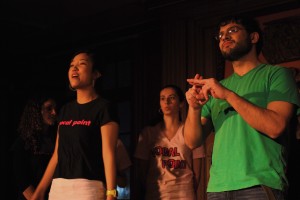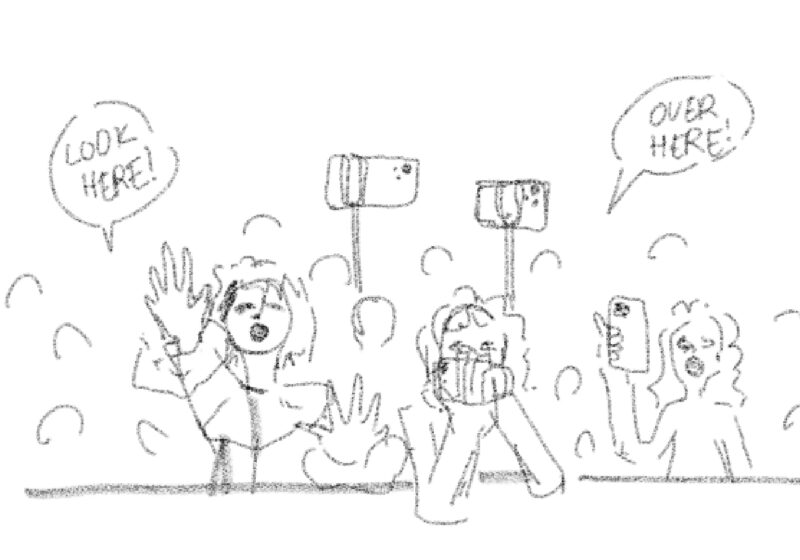
Junior Justin Gumina, president of the ASL club, performs along with some Vocal Point members. Hannah Bazarian- Photo Editor
The “Exposure” show, put on by UR’s American Sign Language performance group, Sign Language Associated Performers (S.L.A.P), accomplished precisely what it set out to do: Educating the University community about deaf culture in a humorous, entertaining and visually captivating manner.
Calling the show a hit would be an understatement. Within four minutes of the doors opening, the Drama House was packed, and students had to be turned away. It was evident that members of the community at large were also present at the show, a mark of the program’s true outreach and success.
Co-directed and written by junior Mel Balzano and sophomore Sura Lutvak, “Exposure” integrated popular songs into an overarching story line in a “Moulin Rouge”-esque manner, with the added, or rather integral, element of ASL. The story line was basic- — a mere narrated backdrop to the dramatic and musical scenes presented by members of TOOP, Vocal Point and After Hours. Some of the music was piped in to accommodate the pre-existing set lists of the a cappella groups.
The point, though, was ultimately the ASL interpretations of the music and dialogue. The fluidity of the performers as they translated the music into ASL, an incredibly beautiful language, provided an exceptionally captivating experience for the audience members. ASL, like any other language, has its own syntax and grammar, rendering exact translations impossible. This was especially evident in the signing of Sara Bareilles’ “King of Anything,” where the signer flipped off the audience, and if you’re familiar with the lyrics, you know that’s not exactly a direct translation.
Balzano explained that the object of the translations was to capture the sentiments of the lyrics, rather than attempting to directly translate every phrase, which may not have an ASL equivalent. Even for someone with little to no knowledge of ASL, discrepancies were evident between the English and ASL versions of the scenes, but this immutably enriched the “Exposure” experience.
The result of the combination was rather like one person patting your head and another rubbing your stomach, and it is part of the magic of sign language that even without understanding everything, one can still follow the more obvious signs.
I do, however, wish I could have appreciated some of the subtler aspects of signing — fluent audience members would frequently laugh and clap at jokes and artistic licenses that I could not understand.
The show sought — and was able — to expose members of the hearing community to the standard life trajectory of a deaf or hearing-impaired child born to hearing parents. The story followed a profoundly hearing-impaired boy who was not taught ASL until his early teen years.
Up to that point he relied solely on speech therapy and hearing aids for communication, but these insufficient measures negatively impacted his social and academic abilities.
Ninety percent of deaf children are born to hearing parents, and raising a deaf child can be an unexpected burden for many unprepared parents, who are then faced with the necessity of learning a new language at the drop of a hat in order to raise their child.
The music that was selected to support the show all wove into the story arc, with themes that connected to and complemented the episodic sketches, which depicted the boy’s life.
Although it was evident with every song how the message of the music played into the show at large, the songs were isolated entities in themselves. The music had no flow from number to number, even when performed consecutively, but this didn’t negatively impact the show.
Balzano provided some further insight into the phenomenon of signing songs, describing it as a means of bridging the gap between Deaf and hearing cultures. After attending the “Exposure” show, it was easy to see why; ASL is like a pure form of performance art in itself.
One of the most meaningful moments of the show came during the last song. The entire cast got on stage to sign the grand finale together, and during the last 30 seconds the sound was suddenly cut.
This sudden sensory deprivation was certainly a big shock for the hearing members of the audience: A sudden injection of insight into what it would be like to no longer experience any auditory input.
Throughout the course of the show, I had been enjoying songs that I was familiar with, from Ingrid Michaelson’s “The Way I Am” to Journey’s “Don’t Stop Believin’,” and I was continually amazed by the grace and beauty of the signed interpretations.
But somehow it was not impressed upon me until those last moments what it would be like to never hear the music that is part of a college student’s everyday life.
McLaughlin is a member of the class of 2014.





